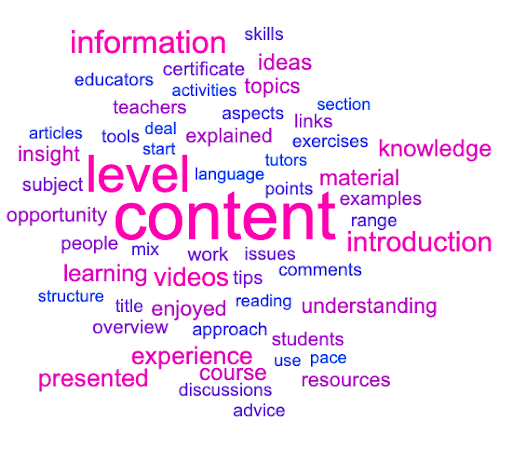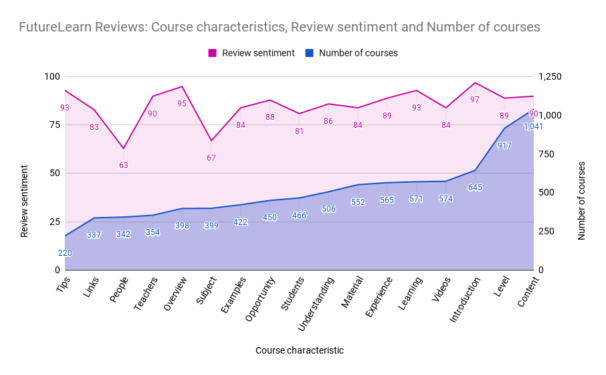Sharing what learners value the most: unpacking a year’s worth of FutureLearn course reviews
We take a detailed look at our course reviews to find out what our learners value the most.

Course reviews are packed full of learners’ opinions about FutureLearn courses. Each review tells a story, what the learner found most meaningful, the good and bad, about their experience. We read reviews as critical feedback. They are honest and well-intentioned, encouraging learner’s openness and reflection. They are also public – reviews build a channel between one user and the next.
In this blog post, we wanted to share our insights from one year’s worth of course reviews. We used machine learning to categorise free-text content into themes. These themes tell a new story – how individual experience can show wider perspectives on which characteristics of a FutureLearn course learner found most valuable.
Learners ❤️ Content
Content is the single most popular characteristic when it comes to course reviews. The word cloud below shows the top 54 course characteristics based on frequency (i.e. how many times they were written).
Learners expect high-quality content; they look for it to be ‘interesting’, ‘easy to understand’, ‘informative’ and ‘useful’.
These quotes are also summaries of thousands of reviews that mention ‘content’. We also know that the term ‘content’ is vague and that there’s so much variety; media, construction, message, tone, narrative, people, language, etc. So we dug deeper into reviews because learners share so much more…
Top course characteristics
The chart below is more revealing – it shows the top 17 course characteristics that surfaced within reviews. A characteristic had to be mentioned over 500 times before it made this top list. Each mention could have been positive, neutral or negative – they are all counted in the overall ‘Review sentiment’. Sentiment is calculated by the percentage of negative mentions subtracted from the percentage of positive mentions per characteristic.
The pink area shows the overall sentiment – which can range between -100 (bad) to +100 (good). The blue area shows the volume of courses for each topic mentioned.
The chart helps create new insights into what our engaged learners valued the most. It also shows where we can improve. Our analysis shows two characteristics; ‘People’ and ‘Subject’ had lower sentiment than others. This means more negative opinions for those two characteristics, which we are reflecting upon and finding ways to improve this part of our learner experience.
The chart also highlights opportunities for future course development. The characteristics being shared here were instrumental to our learner’s collective experiences. Many people use reviews for decision making. If a course contains ‘useful’, ‘practical’ and ‘informative’ tips, then one learner can share this with the next, demonstrating that this was valuable and helping others make a value judgement for enrolment and purchase. The same goes for if the course did not perform well in an area; it signals that improvements are due.
Tips – the perfect example of what learners value
Let’s focus on tips, because it’s an area that really demonstrates what learners value. It also feels universal in value, once you think about it. We know many of our learners study on FutureLearn to get ahead in their careers or because they want to explore a topic for their passion, hobby and love of learning.
Fewer than average courses contained reviews mentioning tips in the content, comments and emails. Those that did gained hundreds of positive reviews from learners that specifically mentioned them in reviews. Learners are telling us, quite openly, that they value tips!
This includes:
- Tips from educators
- Practical and useful tips were the highlight of the course
- Making learning actionable made the course visible and immediate
- Tips from other learners/peers which adds a new dimension to the content
- Balanced content with practical tips
- Ways to be engaged and have ‘more to think about’
- Learning how to learn is a challenge; tips bring learning to life / reality.
So what should we do? Put more tips in our content! On seeing this, why wouldn’t you?
Links – another great example
Adding links to courses, across the content, helps engage learners. They can dig deeper into the topic and share further reading or additional resources with peers via social learning. Adding links might sound simple – that’s one of the best parts. They don’t need to distract from the core learning while adding additional value to learners who want to explore further or pick up some of the basics before moving on.
Learner feedback from additional links tells us:
- Further reading can complement the content and allow deeper self-paced learning
- Peers sharing links adds extra depth to the course content
- Extra links bring further tools and resources
- Links create takeaway content for sharing and reuse
- Bring learners up to the same level with extra content, or supporting more advanced learners to go further
- Helping learners to broaden their perspective
- Repeat enrolments tend to expect extra links in all courses
These are just two of the 17 top characteristics that surfaced from learners in our analysis. Each of these characteristics deserves its own space for how to include them in courses. To make this blog post digestible, we’ve condensed the info into a document on course characteristics valued by learners. We’re sharing because we think many more learners will benefit from this insight.
Download the document
Use our insights for your own courses
The list of course characteristics is available to download. It is not an exhaustive list, we have more characteristics we’re still learning about and we know there’s so much that goes into successful learning. We just wanted to share this list for those who are building and revising courses.
The list is also somewhat universal for many courses. We hope in sharing this as a resource for educators, learning designers, course developers that it can be used by anyone building effective learning experiences.






